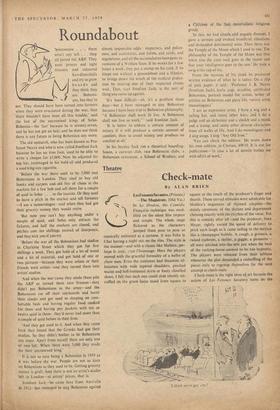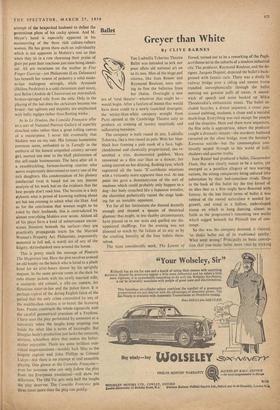Theatre
Check-mate
BRIEN
By ALAN elled on the silent film impure and simple. The whole stage flickered as the characters jumped from pose to pose as comically animated as a cartoon. It was Felix le Chat having a night out on the tiles. The style is the manner—and with a classic like Moliere, per- haps le style, c'est l'hommage. Here the players moved with the graceful formality of a ballet of chess men. Even the costumes had Staunton sil- houettes with wide tapered shoulders, pinched waists and bell-bottomed skirts or finely chiselled shoes. I felt that each one could slide silently un- ruffled on the green baize stand from square to square at the touch of, the producer's finger and thumb. These carved attitudes were admirable for Moliere's sequences of rhymed couplets—the stately ceremony of the diction and deportment chiming exactly with the rhythm of the verse. Yet this is comedy after all--and the producer, Jean Meyer, rightly varied the speed of delivery to prick each laugh as it came sailing to the surface like a champagne bubble. A cough, a grimace, a raised eyebrow, a stutter, a giggle, a pirouette— all were stitched into the text just when the beat of the rocking-horse. seemed to be too hypnotic. The players were released from their tableau whenever the plot demanded a reshuffling of the pieces only to regroup themselves for the next attempt at check-mate.
Check-mate is the right term of art because the action of Les Femmes Savantes turns on the
think we've got em
attempt of the henpecked husband to defeat the pretentious plans of his cocky spouse. And M. Meyer's hand is especially apparent in his manoeuvring of the three rich culture-vulture women. He has given them each an individuality which is not apparent in Moliere's text so that when they sit in a row chorusing their praise of their pet poet their reactions just miss being identi- cal. All are variations on the mother in Five Finger Exercise—yet Philaminte (Lisa Delamare) has beneath her veneer of pedantry a solid made- to-last mahogany strength, while Armande (Helene Perdriere) is a cold chromium steel ninny, and Belise (Andree de Chauveron) an overstuffed, broken-springed relic from the attic. Only in the playing of the last does the caricature become too broad—her ugliness and stupidity are emphasised with hefty nqdges rather than fleeting winks.
As in Le Dindon, the Comedic, Francaise offer us a sort of National Portrait Gallery of superbly sketched roles rather than a great rolling canvas of a masterpiece. 1 never felt eventually that Moliere was on my side. His famous humanistic common sense, embodied as in Tartuffe in the outburst of the honest unspoiled country servant girl, seemed too near to the bluff philistinism of the self-made businessman. The hero after all is a swashbuckling, fortune-hunting courtier who seems suspiciously determined to marry one of the rich daughters. His condemnation of his phoney intellectual rival is based not on any literate analysis of his work but on the evidence that the best people don't read him. The heroine is a lazy slyboots who is proud of knowing nothing about art but too cunning to admit what she likes. And as for the conclusion that women ought to be ruled by their husbands, this is contradicted by almost everything Moliere ever wrote. Almost all of his plays have a kind of subterranean uncon- scious lbsenism beneath the surface—they are practically propaganda tracts for the Married Women's Property Act. Philaminte, impressively mounted in full sail, is worth ten of any of the fidgety, skrimshanked men around the house.
This is pretty much the message of Pinero's The Magistrate too. Here the plot revolves around an old booby on the bench who is lured to a plush hotel for an after-hours dinner by his sprightly stepson. In the same private room in the dark he rubs dinner jackets with his newly married wife, a mustardy old colonel, a silly-ass captain, his flirtatious sister-in-law and the police force.. It is perhaps typical of the daring English farce of the period that the only crime committed by any of the middle-class victims is to break the licensing laws. Pinero constructs the whole rigmarole with the careful geometrical precision of a Feydeau. I have seen the play performed by amateurs at a university when the laughs keep erupting one inside the other like a series of hiccoughs. But Douglas Seale's production just lacks the innocent, obvious, schoolboy drive that makes the helter- skelter enjoyable. There are some brilliant indi- vidual impersonations—notably Jack 'May as the languid captain and John Phillips as Colonel Lukyn—but there is no attempt at real ensemble playing. One glance at the Comedic Francaise- even for someone who can only follow the play from the Everyman translatioti—will show the difference. The Old Vic gets Only half the laughs the play deserves. The Comedic FrancaLe gets three times more than the play can justify.







































 Previous page
Previous page